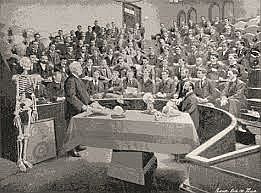This interview took place 46 years ago on June 15th of 1968 when Dr. John Duffy interviewed Dr. Allan D. Sutherland, who was a great homeopath physician and activist in the United States. I’ve excerpted a portion of the original interview to share his remarks about polypharmacy or as Dr. Hahnemann called it: mixopathy.
Dr. Sutherland was born in Northfield, Vermont in the late 1800’s. His ancestors were French-Canadian from Montreal, Canada. At birth, he was delivered by a homeopathic physician, who was a graduate of the New York Homeopathic College. Years later, on the advice of his family physician, he decided to enter Hahnemann Medical College in Philadelphia (1920.) He graduated in 1925 and served an internship at the Children’s Homeopathic Hospital in Philadelphia. Subsequently he was appointed Chief Resident at the Children’s Homeopathic Hospital. After practicing for a year or so in Philadelphia, he moved to Brattleboro in 1928 and thereafter was appointed secretary of the International Hahnemannian Association and editor of the Homeopathic Records. Six years later he became chief editor of the Journal of the American Institute of Homeopaths.
In the interview, Dr. Duffy asked Dr. Sutherland, how he became interested in studying medicine. Dr. Sutherland replied, “I didn’t know much about the difference between homeopathy and orthodox medicine. I don’t like that term because I think homeopathy is also orthodox, but this is the common phrase. I just wanted to be a doctor. This is the way kids think about it. I was then just under twelve years. To me all doctors were alike, and this was the idea I carried through my school days, and even into my college years. I graduated from the Kent School in Connecticut and entered Yale with the idea that I would pick up the required premedical subjects at Yale. I met our friend and family physician, Dr. Roberts, on the street one day and he asked me what I was going to do. I didn’t know at that time and he said, ‘Why don’t you go to Hahnemann?’ I said, ‘Hahnemann, what is that?’ He said: ‘Well, it is a homeopathic medical school in Philadelphia.’
So I did go down to Philadelphia to talk with Dean Pearson at Hahnemann, and found that I didn’t have quite the premedical – I hadn’t completed all, or enough, premedical requirements – so that I could enter as a freshman at medical school in the fall. But at that time Hahnemann had two divisions. One was the medical school and the other was the school of science, which supplied the basic premedical requirements for studying medicine, which the State of Pennsylvania had set up. So in the fall of 1920 I entered the Hahnemann School of Science, taking a sort of combined course just to pick up the subjects that I lacked, in order to enter the homeopathy school. Hahnemann at that time was a Class A medical school. So that is how I happened to be in homeopathy.
Lecture at Hahnemann Medical School
After I got to Hahnemann and got into medical school and began to learn something about homeopathy, I became interested in it, and this was the field in which I wanted to continue. However, one of the problems, I think, with homeopathy has been that so many of the homeopaths have drifted over into standard medicine. Let’s say, there obviously has been pressure upon them in many areas to more or less conform to a practice – we could call it orthodox medicine. I was wondering if, by the 1920’s, this pressure was not one of the factors that tended to make people, I want to say wishy-washy, but let’s say less interested in it. My feeling has always been that one of the major factors in turning out a hybrid homeopath is the fact that the basic principles of homeopathy were not adequately taught in medical schools. Many of the people graduating were not convinced that homeopathy was a valid form of therapeutics; they tended to mix it up with other forms of therapy. And you can’t always do that, in homeopathy. You have to make a medical judgment as to whether in an individual situation you are going to treat this individual homoeopathically, or you are not going to treat him homoeopathically. You would be more successful if you can make this judgment, than to say: ‘well, this fellow needs Bryonia but I am going to give him some aspirin too’. Now this is not homeopathy, it is just a sort of polypharmacy. One thing about homeopathy is that if you use it by itself, without recourse to other methods during the time you are treating a patient homoeopathically, you know that the results are directly related to the therapeutic principles you have applied. But you can’t do it if you are using a hodge-podge, a potpourri of medicine.”
Dr. Allan Sutherland was 70 year old when this interview took place at his home.
Source: U.S. National Library of Medicine.





Very nice
An interesting one. Historian of Homeopathy .. sounds good..